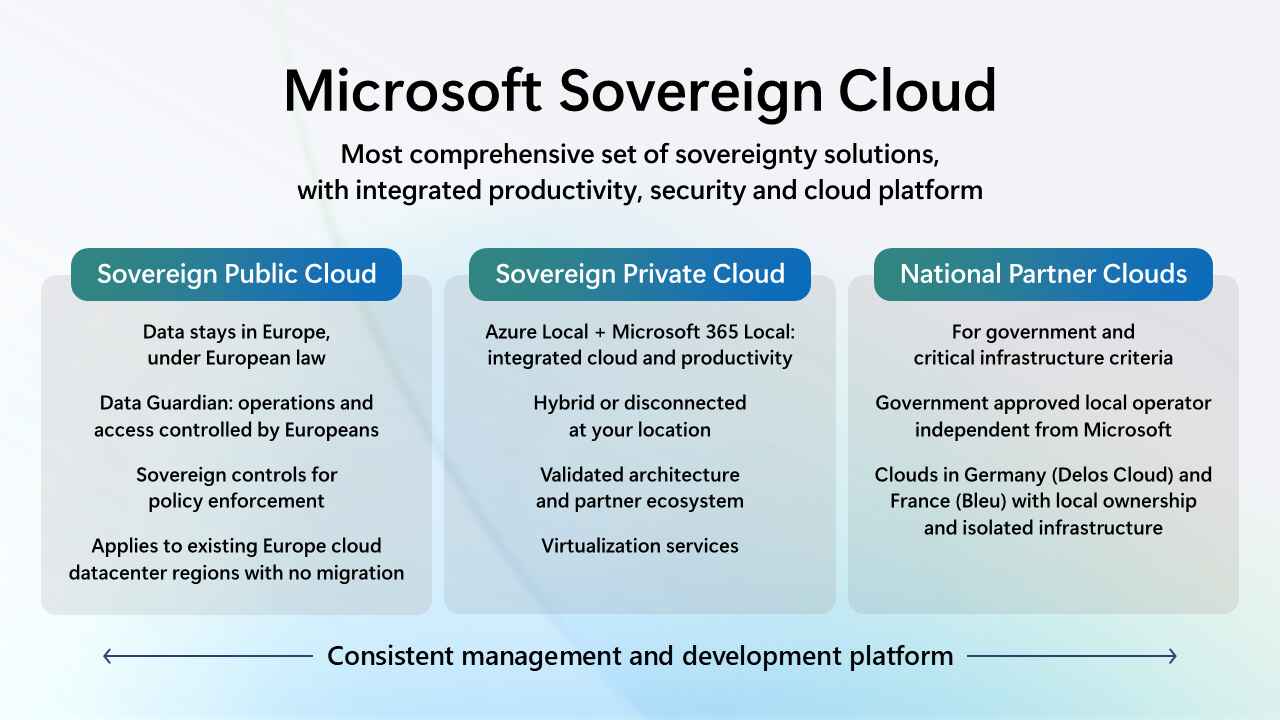Microsoft has launched its “Microsoft Sovereign Cloud,”a comprehensive suite of solutions designed to give European customers unprecedented control over their data. The move is a direct and forceful response to escalating competition from rivals and growing regulatory demands for digital sovereignty across the continent.
The initiative unifies Microsoft’s public, private, and partner cloud offerings under a single banner. It introduces several powerful new technical controls, including a “Data Guardian”feature to ensure European personnel oversee data access, “External Key Management”for customer-controlled encryption, and “Microsoft 365 Local”for running productivity services in fully private, and even air-gapped, environments.
This strategic overhaul significantly expands upon Microsoft’s previous data residency efforts. It signals a new phase in the battle for Europe’s regulated industries, moving beyond simply storing data locally to addressing the more complex issues of operational control, access, and true digital autonomy.

Inside the Sovereign Toolkit: More Than Just Location
The Microsoft Sovereign Cloud is defined by a set of new and enhanced technical controls designed to provide granular governance. Chief among them is Data Guardian, an assurance layer that goes beyond simple data residency by ensuring that only Microsoft personnel residing in Europe can control remote access to the systems processing customer data.
For organizations with the most stringent resiliency or regulatory needs, Microsoft is launching Microsoft 365 Local. This solution allows customers to run core productivity servers like Exchange and SharePoint within their own datacenters, powered by Azure Local technology, giving them full control in a hybrid or even a completely disconnected environment. The offering is further strengthened by two other key announcements:
External Key Management, which allows customers to connect Azure to encryption keys stored on their own on-premises Hardware Security Modules (HSMs). Regulated Environment Management, a centralized service that acts as a dashboard for customers to configure, deploy, and monitor all of their sovereign operations and policies.
While these tools offer greater control, the adoption of sovereign cloud solutions is not without potential trade-offs. According to TechTarget, common challenges can include higher costs compared to standard public cloud offerings and a potential for vendor lock-in due to fewer provider options. Nonetheless, for key partners, the move is a critical enabler.
Aiman Ezzat, CEO of Capgemini Group, stated that “The launch of Microsoft Sovereign Cloud marks a pivotal moment in empowering European institutions and industries with the control, compliance and innovation they need to thrive in today’s digital economy.”
A High-Stakes Battle for Europe’s Cloud
Microsoft’s latest move does not occur in a vacuum. Es un claro mostrador estratégico para su rival principal, Amazon Web Services, que el 3 de junio reveló su propia nube soberana europea de AWS. AWS framed its initiative as a way “to address European digital sovereignty requirements while maintaining the services portfolio, security, reliability, and performance that customers expect,”according to company vice president Kathrin Renz.
The back-to-back announcements from the world’s two largest cloud providers have turned Europe into the central battleground in a rapidly intensifying war for sovereign cloud dominance. The market is substantial, with analyst firm IDC projecting that global spending on sovereign cloud services will reach $258.5 billion by 2027.
While Microsoft and AWS are the lead contenders, other major players like Google, IBM, and Oracle are also offering sovereign solutions to capture a piece of this lucrative market.
For AWS, the launch of a dedicated sovereign cloud marcó un pivote estratégico significativo. The company was previously seen as taking a different approach by focusing on “Dedicated Local Zones”rather than entirely separate sovereign regions. The recent moves by both U.S. tech giants show a clear adaptation to a strong European push for digital autonomy, a sentiment highlighted in March when the EuroStack Initiative urged the European Commission to bolster local digital infrastructure.
From Data Boundary to Digital Fortress
Microsoft’s journey to this point has been a multi-stage evolution, transforming a technical compliance project into a core Pilar Estratégico. The foundational step was the completion of its EU Data Boundary in February, an initiative that ensured customer data for core services like Azure and Microsoft 365 would be stored and processed within the EU and EFTA regions.
This was a direct reaction to regulatory pressure, most notably the 2020 Schrems II ruling, which invalidated the previous EU-U.S. data transfer framework.
Building on that technical foundation, the company in April announced five broad “European Digital Commitments”. These included a legally binding pledge to resist government orders to halt its European operations. At the time, Microsoft President Brad Smith affirmed the company’s dedication, stating that its business is critically dependent on European trust and that Microsoft will “respect European values, comply with European laws, and actively defend Europe’s cybersecurity.”
This commitment to legal and geopolitical stability is part of a wider global trend; at least 137 countries have enacted data protection laws, compelling cloud providers to offer regionalized solutions. The new Microsoft Sovereign Cloud now serves as the comprehensive framework to deliver on those promises, turning high-level principles into a tangible product suite.
The New Front in the Cloud Wars
Ultimately, the launch of the Microsoft Sovereign Cloud and the swift countermove from AWS confirm that data sovereignty is no longer a niche compliance característica. Se ha convertido en un campo de batalla central para la supremacía de la nube, primero en Europa y cada vez más en todo el mundo. The technical advancements in data control are a direct result of intense competitive pressure and a rapidly evolving regulatory landscape.
These comprehensive offerings are setting a new, higher baseline for what it means to be a global cloud provider operating in regulated markets. The moves by Microsoft and AWS will likely force competitors to match this deeper level of regionalized investment and operational control.
For customers, this arms race brings more choice and more powerful tools, but it also introduces a new layer of complexity as they navigate a cloud landscape that is becoming more powerful, more resilient, and more fragmented than ever before.
